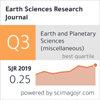Calculation of indicators of maximum extreme temperature in Sinaloa state, northwestern Mexico
IF 0.5
4区 地球科学
Q4 GEOSCIENCES, MULTIDISCIPLINARY
引用次数: 0
Abstract
One of the climate problems that causes the most environmental impact worldwide is the trend of increasing occurrence of events of maximum extreme temperature, signaled by indicators such as hot extremes (HE) and maximum maximorum (highest maximum) temperature (MmT). These events can cause conditions ranging from severe droughts to heat stroke, which can cause death in any population. Indicators of maximum extreme temperature in one of the most important agricultural areas in northwestern Mexico were calculated based on significant trends (ST) and adjusted return periods. To calculate the trends of the maximum extreme temperature, frequency (FR), annual average duration (AAD), annual daily duration (ADD), intensity (IN) of HE, and MmT, the Mann-Kendall and Sen’s slope tests were applied to data obtained for 19 weather stations from the CLImate COMputing database for the period 1982–2014. Adjusted return periods (ARP) were calculated for each indicator of maximum extreme temperature by fitting a probability distribution function. For the study area, the ST and maximum extreme temperature shows a prevailing cooling trend. This can be deduced by observing the proportion of negative ST compared with positive ST. The highest positive magnitudes of ST were recorded at stations CUL (FR = 3.44 HE dec-1), GUT (AAD = 6.15 day HE-1 dec-1 and IN = 13.62 °C dec-1), IXP (ADD = 35.00 day dec-1) and POT (MmT = 2.50 °C day-1 dec-1). For ARP, the estimate of the average occurrence frequency of extreme events per100 years are FR = 6.11 HE dec-1 (1 time), AAD = 6.64 day HE-1 dec-1 (4 times), ADD = 38.68 day dec-1 (1 time), IN = 39.09 °C dec-1 (6 times) and MmT = 41.95 °C day-1 dec-1 (1 time). These findings are of key importance for the economic sectors related to agricultural production in the state known, at least to date, as “the breadbasket of Mexico” (Sinaloa). The results will help to develop adaptation/prevention measures before the coming socioeconomic and hydrological disasters.墨西哥西北部锡那罗亚州最高极端温度指标的计算
在全球范围内造成最大环境影响的气候问题之一是最高极端温度事件的发生呈增加趋势,其标志是极端高温(HE)和最高最高温度(MmT)等指标。这些事件可能导致从严重干旱到中暑的各种情况,这可能导致任何人群死亡。根据显著趋势(ST)和调整后的回归期计算了墨西哥西北部最重要农业区之一的最高极端温度指标。利用1982—2014年气候计算数据库中19个气象站的数据,采用Mann-Kendall和Sen’s斜率检验,计算了最高极端温度、频率、年平均持续时间、年日持续时间、强度和MmT的变化趋势。通过拟合概率分布函数,计算最高极端温度各指标的调整回归期(ARP)。研究区温度和最高极端温度总体呈降温趋势。这可以通过观察负ST与正ST的比例来推断。最高的ST阳性值记录在CUL (FR = 3.44 HE- dec-1)、GUT (AAD = 6.15 HE- dec-1, IN = 13.62°C dec-1)、IXP (ADD = 35.00 day dec-1)和POT (MmT = 2.50°C day- dec-1)站点。对于ARP,每100年极端事件的平均发生频率估计为FR = 6.11 HE- dec-1(1次),AAD = 6.64 day HE- dec-1(4次),ADD = 38.68 day dec-1(1次),IN = 39.09°C dec-1(6次),MmT = 41.95°C day- dec-1(1次)。这些发现对锡那罗亚州的农业生产相关经济部门至关重要,至少到目前为止,锡那罗亚州被称为“墨西哥的粮仓”。研究结果将有助于在即将到来的社会经济和水文灾害之前制定适应/预防措施。
本文章由计算机程序翻译,如有差异,请以英文原文为准。
求助全文
约1分钟内获得全文
求助全文
来源期刊

Earth Sciences Research Journal
地学-地球科学综合
CiteScore
1.50
自引率
0.00%
发文量
0
审稿时长
>12 weeks
期刊介绍:
ESRJ publishes the results from technical and scientific research on various disciplines of Earth Sciences and its interactions with several engineering applications.
Works will only be considered if not previously published anywhere else. Manuscripts must contain information derived from scientific research projects or technical developments. The ideas expressed by publishing in ESRJ are the sole responsibility of the authors.
We gladly consider manuscripts in the following subject areas:
-Geophysics: Seismology, Seismic Prospecting, Gravimetric, Magnetic and Electrical methods.
-Geology: Volcanology, Tectonics, Neotectonics, Geomorphology, Geochemistry, Geothermal Energy, ---Glaciology, Ore Geology, Environmental Geology, Geological Hazards.
-Geodesy: Geodynamics, GPS measurements applied to geological and geophysical problems.
-Basic Sciences and Computer Science applied to Geology and Geophysics.
-Meteorology and Atmospheric Sciences.
-Oceanography.
-Planetary Sciences.
-Engineering: Earthquake Engineering and Seismology Engineering, Geological Engineering, Geotechnics.
 求助内容:
求助内容: 应助结果提醒方式:
应助结果提醒方式:


